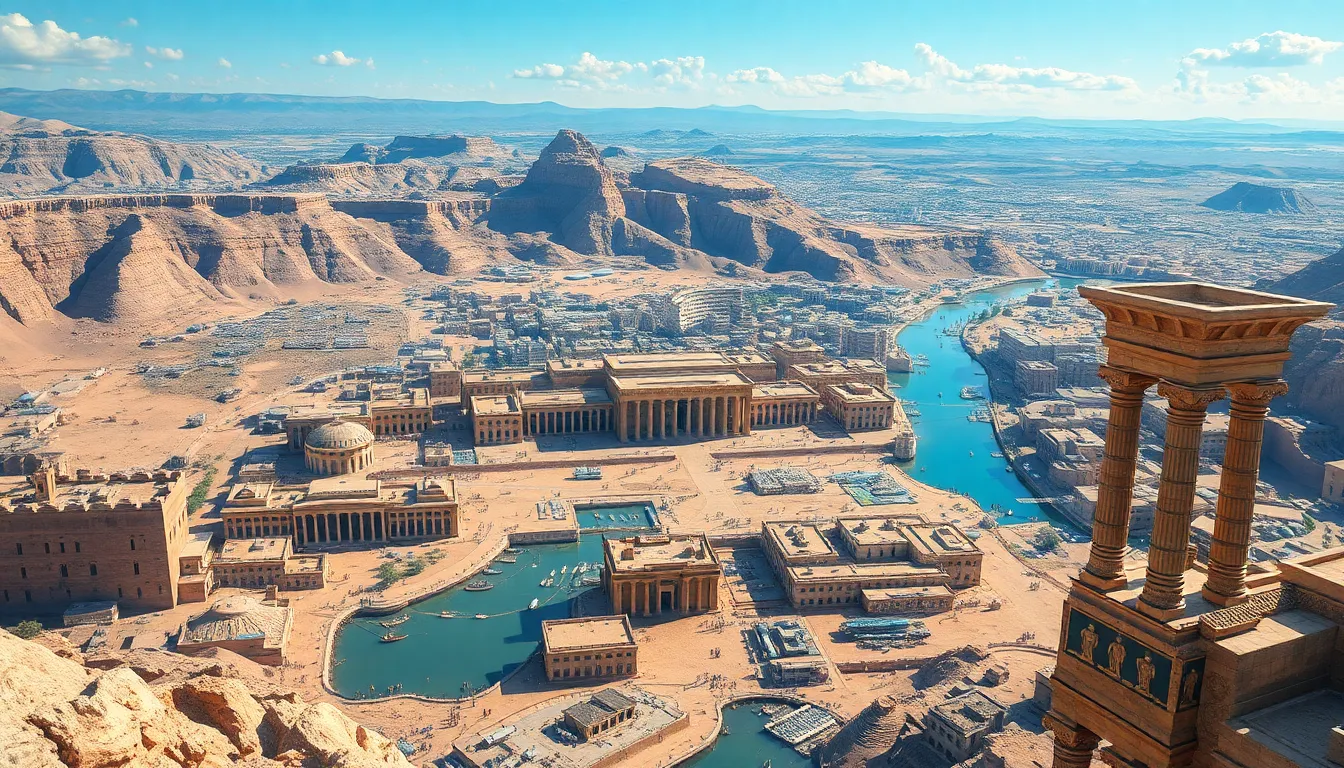The Mythical Geography of the City of Thebes
I. Introduction
The ancient city of Thebes holds a revered place in mythology, brimming with tales of gods, heroes, and epic events that shaped the cultural landscape of ancient Greece. Nestled in the heart of Boeotia, Thebes was not only a political and military power but also a vital mythological center. The geography of Thebes significantly influenced its mythological narratives, creating a rich tapestry of stories that define its legacy. This article aims to explore the mythical geography of Thebes, examining its historical context, topography, divine sites, cultural influences, symbolism, and archaeological discoveries.
II. Historical Context of Thebes
Thebes’ founding myths are steeped in legend. According to some accounts, the city was established by Cadmus, who followed a divine cow and built the city where it lay down. This myth highlights the importance of divine guidance and the interplay between fate and human endeavor in ancient narratives.
In Greek mythology, Thebes is often seen as a rival to Athens, featuring prominently in stories such as the tale of Oedipus, who unwittingly killed his father and married his mother, leading to tragic consequences. Thebes was also the birthplace of Hercules, one of the greatest heroes in Greek mythology, further cementing its importance in the mythological canon.
Key historical events, such as the battles of the Seven Against Thebes and the eventual rise of Theban power, particularly under leaders like Epaminondas, added layers to its legendary status, making it a focal point of both myth and history.
III. The Topography of Thebes
The geographic location of Thebes, situated near the banks of the river Ismene and surrounded by the rugged terrain of the Cithaeron and Helicon mountains, played a crucial role in its development. The city’s strategic position allowed for both agricultural prosperity and military strength.
The surrounding mountains and rivers held significant meaning in mythology:
- Cithaeron: Often associated with the rites of Dionysus, this mountain is steeped in stories of revelry and tragedy.
- Helicon: Home to the Muses, Helicon inspired countless tales of artistic creation and divine intervention.
- Ismene River: Frequently mentioned in myths, the river symbolizes both life and the passage of time, marking the boundaries between the mortal and divine realms.
The geography of Thebes not only influenced its physical growth but also served as a backdrop for many mythological events, reinforcing the connection between the land and its stories.
IV. The Divine and Heroic Sites of Thebes
Thebes was dotted with temples and shrines dedicated to various gods, enhancing its status as a religious center. Key sites include:
- The Temple of Apollo: A significant site for oracles and prophecies.
- The Sanctuary of Dionysus: Central to the worship of the god of wine and theater, this site was pivotal for the development of drama.
- The Hero Shrine of Heracles: Celebrating the legendary feats of Hercules, this site reflects the city’s heroic legacy.
Additionally, legendary locations associated with heroes, such as the foundations laid by Cadmus and the remnants of the Seven Against Thebes, contributed to the city’s rich mythological tapestry. These sites served as physical manifestations of the stories told by poets and playwrights, reinforcing the importance of Thebes in mythic storytelling.
V. The Influence of Theban Myths on Culture
Theban myths have had a profound impact on literature and drama throughout the ages. The stories of Oedipus, Antigone, and the Labdacids have inspired countless adaptations and interpretations, becoming staples of classical literature. The tragedies penned by playwrights like Sophocles and Euripides are testaments to the enduring power of these narratives.
Artistic representations of Theban geography and mythology have flourished, from vase paintings to monumental sculptures. These works often depict key mythic events set against the backdrop of Thebes, illustrating the interplay between geography and myth.
In modern culture, Theban legends continue to resonate, influencing contemporary literature, theater, and even film, as the themes of fate, identity, and familial conflict remain relevant in today’s society.
VI. The Symbolism of Theban Geography
The geography of Thebes is laden with symbolism, where specific locations carry deeper meanings within myths. For example:
- Thebes as a symbol of duality: The city represents both civilization and chaos, embodying the tension between order and disorder.
- Mountains as barriers: The surrounding mountains often symbolize the challenges that heroes must overcome in their quests.
- Rivers as life-givers: The Ismene River reflects the flow of life and the inevitability of fate, marking the passage of time in mythological narratives.
The interplay between geography and character development is evident in the myths of Thebes. Characters often face trials that mirror the challenges posed by the land itself, reflecting a profound connection between the environment and the human experience.
VII. Archaeological Discoveries and Their Impact
Archaeological excavations in and around Thebes have uncovered significant sites that shed light on its mythological and historical narratives. Key discoveries include:
- The Cadmea: The citadel of Thebes, offering insights into the city’s fortifications and urban planning.
- The Sanctuary of Hercules: Providing evidence of the hero’s worship and the importance of heroic narratives in Theban culture.
- The Theatre of Thebes: A site revealing the city’s role in the development of Greek drama and its cultural significance.
These findings have reshaped our understanding of Theban myths, allowing historians and archaeologists to connect the dots between myth and reality. The relationship between mythology and historical geography is increasingly recognized as a vital aspect of comprehending ancient societies.
VIII. Conclusion
The mythical geography of Thebes is a rich and complex tapestry that has shaped its identity throughout history. From its founding myths to its role in Greek culture, Thebes remains a significant symbol of the interplay between geography and mythology. The enduring legacy of Theban myths continues to influence contemporary society, demonstrating the timeless nature of these narratives. Future research into Thebes and its mythology promises to uncover even more connections between its storied past and the landscapes that shaped it.




